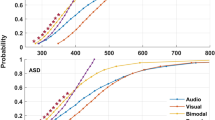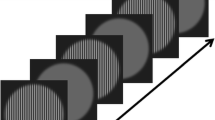Abstract
We compared judgements of the simultaneity or asynchrony of visual stimuli in individuals with autism spectrum disorders (ASD) and typically-developing controls using Magnetoencephalography (MEG). Two vertical bars were presented simultaneously or non-simultaneously with two different stimulus onset delays. Participants with ASD distinguished significantly better between real simultaneity (0 ms delay between two stimuli) and apparent simultaneity (17 ms delay between two stimuli) than controls. In line with the increased sensitivity, event-related MEG activity showed increased differential responses for simultaneity versus apparent simultaneity. The strongest evoked potentials, observed over occipital cortices at about 130 ms, were correlated with performance differences in the ASD group only. Superior access to early visual brain processes in ASD might underlie increased resolution of visual events in perception.




Similar content being viewed by others
References
American Psychiatric Association. (2000). Diagnostic and statistical manual of mental disorders (4th ed.). Washington, DC: American Psychiatric Press, Inc.
Berg, P., & Scherg, M. (1994). A multiple source approach to the correction of eye artifacts. Electroencephalography and Clinical Neurophysiology, 90(3), 229–241.
Braeutigam, S., Rose, S. P. R., Swithenby, S. J., & Ambler, T. (2004). The distributed neuronal systems supporting choice-making in real-life situations: Differences between men and women when choosing groceries detected using magnetoencephalography. European Journal of Neuroscience, 20(1), 293–302.
Brecher, G. A. (1932). Die Entstehung und biologische Bedeutung der subjektiven Zeiteinheit – des Momentes. Zeitschrift fuer vergleichende Physiologie, 18, 204–243.
Chiron, C., Leboyer, M., Leon, F., Jambaque, L., Nuttin, C., & Syrota, A. (1995). SPECT of the brain in childhood autism: Evidence for a lack of normal hemispheric asymmetry. Developmental Medicine and Child Neurology, 37(10), 849–860.
Corbin, H. H. (1942). The perception of grouping and apparent movement in visual depth. Archives of Psychology, 273, 5–50.
Dakin, S., & Frith, U. (2005). Vagaries of visual perception in autism. Neuron, 48, 497–507.
Edgin, J. O., & Pennington, B. F. (2005). Spatial cognition in autism spectrum disorders: Superior, impaired, or just intact? Journal of Autism and Developmental Disorders, 35(6), 729–745.
Efron, R. (1963). The effect of handedness on the perception of simultaneity and temporal order. Brain, 86, 261–284.
Elliott, M. A., Shi, Z., & Surer, F. (2007). The effects of subthreshold synchrony on the perception of simultaneity. Psychological Research, 71, 687–693.
Falter, C. M., Elliott, M., & Bailey, A. (2012). Increased perceptual resolution: Temporal event-structure coding in autism spectrum disorders. PlosOne, 7(3), 1–6.
Falter, C. M., Plaisted, K. C., & Davis, G. (2008). Visuo-spatial processing in autism—testing the predictions of extreme male brain theory. Journal of Autism and Developmental Disorders, 38(3), 507–515.
Falter, C. M., Plaisted Grant, K. C. P., & Davis, G. (2010). Object-based attention benefits reveal selective abnormalities of visual integration in autism. Autism Research, 3(3), 128–136.
Gage, N. M., Juranek, J., Filipek, P. A., Osann, K., Flodman, P., Isenberg, A. L., et al. (2009). Rightward hemispheric asymmetries in auditory language cortex in children with autistic disorder: An MRI investigation. Journal of Neurodevelopmental Disorders, 1, 205–214.
Gur, M., & Snodderly, D. M. (1997). A dissociation between brain activity and perception: Chromatically opponent cortical neurons signal chromatic flicker that is not perceived. Vision Research, 37(4), 377–382.
Happe, F., & Frith, U. (2006). The weak coherence account: Detail-focused cognitive style in autism spectrum disorders. Journal of Autism and Developmental Disorders, 36(1), 5–25.
Haynes, J. D., & Rees, G. (2005). Predicting the orientation of invisible stimuli from activity in human primary visual cortex. Nature Neuroscience, 8(5), 686–691.
Haynes, J. D., Roth, G., Stadler, M., & Heinze, H. J. (2003). Neuromagnetic correlates of perceived contrast in primary visual cortex. Journal of Neurophysiology, 89(5), 2655–2666.
Hommel, B., Müsseler, J., Aschersleben, G., & Prinz, W. (2001). The theory of event coding (TEC): A framework for perception and action planning. Behavioural and Brain Sciences, 24(5), 849–937.
Inquisit 3 (Computer software). (2003). Seattle, WA: Millisecond Software.
Jarrold, C., Gilchrist, I. D., & Bender, A. (2005). Embedded figures detection in autism and typical development: Preliminary evidence of a double dissociation in relationships with visual search. Developmental Science, 8(4), 344–351.
Leekam, S. R., Nieto, C., Libby, S. J., Wing, L., & Gould, J. (2007). Describing the sensory abnormalities of children and adults with autism. Journal of Autism and Developmental Disorders, 37, 894–910.
Lord, C., Risi, S., Lambrecht, L., Cook, E. H., Leventhal, B. L., DiLavore, P. C., et al. (2000). The autism diagnostic observations schedule-generic: A standard measure of social and communication deficits associated with the spectrum of autism. Journal of Autism and Developmental Disorders, 30, 205–223.
Lord, C., Rutter, M., & Le Couteur, A. (1994). Autism diagnostic interview—revised: A revised version of a diagnostic interview for caregivers of individuals with possible pervasive developmental disorders. Journal of Autism and Developmental Disorders, 24, 659–685.
Mottron, L., & Burack, J. (2001). Enhanced perceptual functioning in the development of autism. In J. A. Burack, A. Charman, N. Yirmiya, & P. R. Zelazo (Eds.), Development and autism: Perspectives from theory and research (pp. 131–148). Mahwah, NJ: Erlbaum.
Mottron, L., Burack, J. A., Stauder, J. E. A., & Robaey, P. (1999). Perceptual processing among high-functioning persons with autism. Journal of Child Psychology and Psychiatry, 40, 203–211.
Plaisted, K. C. (2001). Reduced generalization in autism: An alternative to weak central coherence. In J. A. Burack, A. Charman, N. Yirmiya, & P. R. Zelazo (Eds.), The development of autism: Perspectives from theory and research (pp. 149–169). Hillsdale, NJ: Lawrence Erlbaum Associates.
Plaisted, K., O’Riordan, M., & Baron-Cohen, S. (1998). Enhanced visual search for a conjunctive target in autism: A research note. Journal of Child Psychology and Psychiatry, 39, 777–783.
Plaisted, K., Swettenham, J., & Rees, L. (1999). Children with autism show local precedence in a divided attention task and global precedence in a selective attention task. Journal of Child Psychology and Psychiatry, 40, 733–742.
Rock, I., & Brosgole, L. (1964). Grouping based on phenomenal proximity. Journal of Experimental Psychology, 67(6), 531–538.
Rock, I., & Ebenholtz, S. (1962). Stroboscopic movement based on change of phenomenal rather than retinal location. The American Journal of Psychology, 75(2), 193–207.
Shah, A., & Frith, U. (1983). An islet of ability in autistic children: A research note. Journal of Child Psychology and Psychiatry, 24(4), 613–620.
Soulieres, I., Zeffiro, T. A., Girard, M. L., & Mottron, L. (2011). Enhanced mental image mapping in autism. Neuropsychologia, 49(5), 848–857.
Tallal, P., Miller, S., & Fitch, R. H. (1993). Neurobiological basis of speech: A case for the preeminence of temporal processing. Annals New York Academy of Sciences, 682(1), 27–47.
Trevarthen, C., & Daniel, S. (2005). Disorganized rhythm and synchrony: Early signs of autism and Rett syndrome. Brain and Development, 27(Suppl 1), 25–34.
Wechsler, D. (1999). Wechsler abbreviated scale of intelligence. San Antonio, TX: The Psychological Corporation.
Acknowledgments
We thank all participants for their time and commitment and the Baily Thomas Charitable Trust for financial support. CMF was supported by a German Research Council (DFG) Fellowship.
Author information
Authors and Affiliations
Corresponding author
Rights and permissions
About this article
Cite this article
Falter, C.M., Braeutigam, S., Nathan, R. et al. Enhanced Access to Early Visual Processing of Perceptual Simultaneity in Autism Spectrum Disorders. J Autism Dev Disord 43, 1857–1866 (2013). https://doi.org/10.1007/s10803-012-1735-1
Published:
Issue Date:
DOI: https://doi.org/10.1007/s10803-012-1735-1




